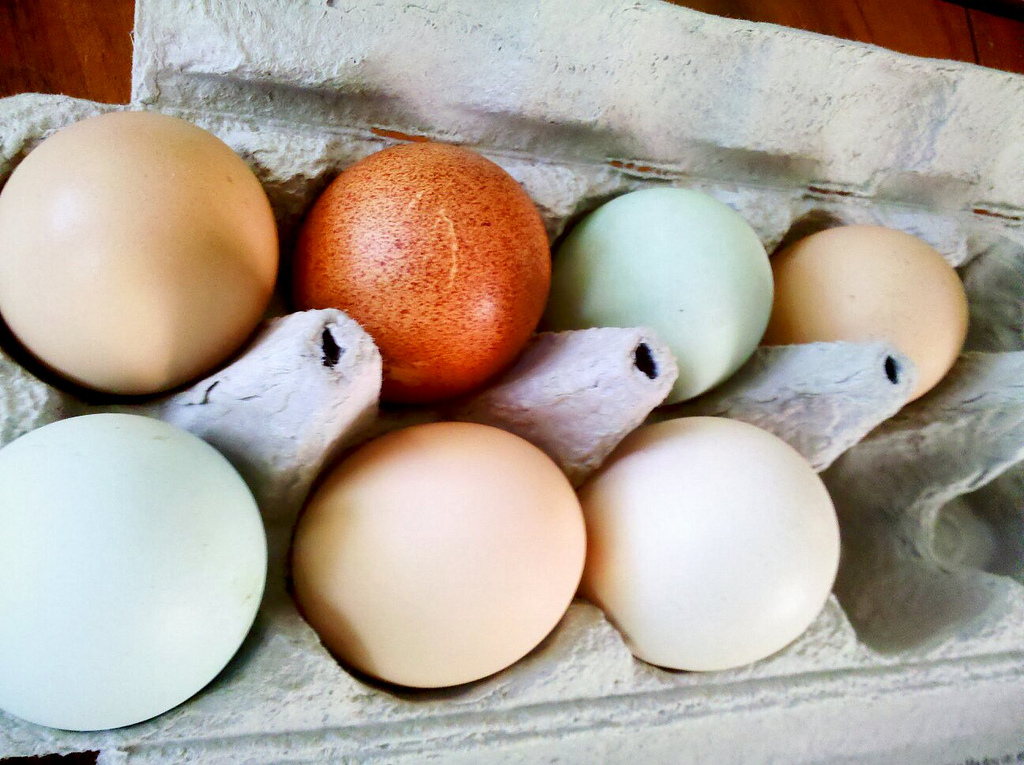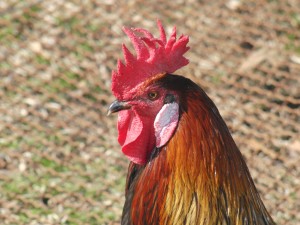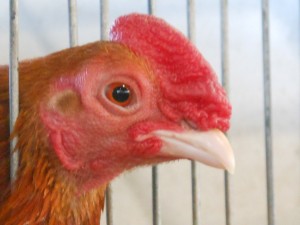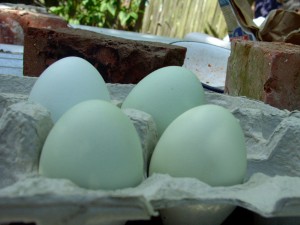Ears and Eggs. In chickens the two are oddly linked. There is a general rule that the color of a chicken’s ear (actually it’s earlobes, since the ears are covered in feathers and not readily visible) can help you determine what color of egg that chicken will lay. Chickens with white earlobes lay
white eggs, while chickens with red earlobes tend to lay brown eggs. Some examples of classic white egg-laying breeds include: Andalusians, Faverolles, Leghorns and Lakenvelders. Examples of a few brown egg-laying breeds include: Barnevelders, Rhode Island Reds, Welsummers, Jersey Giants, Delawares and Orpingtons, whose egg colors vary from light cream to dark brown. There are exceptions to this rule however. The Dorking chicken has red earlobes and yet lays a white egg.
Chicken aficionado, Gail Damerow, wrote in her book, “Your Chickens: A Kid’s Guide to Raising and Showing,” that chickens that are from a Mediterranean background tend to lay white shelled eggs. Damerow further observed that brown shelled eggs were generally layed by the American breeds of chickens. Though Damerow’s observation of the regional heritage of chickens relating to their egg shell color may be overall true, there are of course exceptions to this generality. For example, the Maran breed was developed in France and yet it has red earlobes.
Blue eggs are derived from the South American breed, Araucanas (and their close cousins the Ameraucanas) or from the two Chinese rare breeds of Lushi and Dongxiang chickens. The blue pigment, which is actually inside the eggshell – not just a coating on the surface of the egg, is the result of a harmless retrovirus. These blue egg-layers are often cross bred with brown egg-layers (e.g. Australorps or Marans) to create various shades of green eggs – which can range from light green to dark olive green. Chickens can also produce thicker blooms (also called cuticles) which can cause eggs to be pink, purple or even gray in color depending on the base color of the egg.
Although egg color is a largely cosmetic issue, with no effect on egg quality or taste, it is a major issue in production due to regional and national preferences for specific colors, and the results of such preferences on demand. In most regions of the United States, white eggs are preferred, though certain regions, such as New England prefer brown eggs. (Maybe that’s because it is the birth area of the Rhode Island Red, the Delaware and other American brown egg-laying breeds). Brown eggs are also preferred in many European and South American countries. Some Asian Countries, such as Japan for example, prefer white eggs.
CHICKEN NEWS:
- Popular Science – Blue Eggshells Means Your Chicken Has a Virus ARTICLE
- Business Standard – Blue Eggshell Mystery Solved ARTICLE
- Watchingthewatchers – A Retrovirus Makes Chicken Eggshells Blue ARTICLE
- Saturn – Oocyan and Making Blue Eggs ARTICLE
MAIN SEGMENT:
- Scratch Cradle – The Genetics of Egg Color ARTICLE
- Scratch Cradle – How to Breed for Blue Eggs ARTICLE
- Scratch Cradle – Breeding for Other Colors ARTICLE
- Broad Leys Publishing – Breeding for Different Eggshell Colors ARTICLE
- Henderson’s Chicken Breed Chart – Giving Chicken Breed & Egg Color CHART
- Broad Leys Publishing – Chart of Chickens/Eggshell Colors CHART
- Hen Cam blog – Feathers, Ears and Ears POST
- Gorge Living – “Chickens” an article about chickens and eggs LINK
- Grit – How a Chicken Makes a Shell ARTICLE
- Gail Damerow –Your Chickens: A Kid’s Guide to Raising and Showing
SALLY’S SIDENOTES:
- Winner of Lisa Steel’s book Fresh Eggs Daily: Raising Happy, Healthy Chickens…Naturally is Mr. Bobby Martin of Decatur, Alabama. Congratulations!
Podcast: Play in new window | Download | Embed
Subscribe: Apple Podcasts | RSS





